A video has appeared online showing Russian military personnel approaching Pokrovsk on motorcycles, buggies, and cars under the cover of thick fog — footage that has heightened fears of a possible defense breakthrough at this strategic transport and railway hub in southeastern Ukraine.
A video is being shared online showing groups of soldiers and equipment moving in the fog towards Pokrovsk — a fact that Western media have already dubbed “movie-like scenes” and which has caused alarm over the possibility of further enemy advances.
According to Ukrainian military and Western media reports, there are already about 300 Russian soldiers in the city; Moscow is stepping up efforts to wedge into the northern outskirts of Pokrovsk and try to surround the agglomeration. This makes the city one of the hottest spots on the front line - by some estimates, this section accounts for a significant portion of the fighting along the front line.
The fighting is going on "house by house" among the ruins of high-rise buildings: the defenders are holding their positions despite the enemy's significant superiority in intensified assault attempts. Analysts note that the Moscow forces are using tactics of frequent small sabotage groups and massive waves of infantry, which brings local but costly gains - similar to the tactics under Bakhmut.
Ukrainian military and experts warn that the fall of Pokrovsk would mean a serious strategic and moral blow: the city is an important logistical hub, its loss opens up directions to the north and west and threatens the chain of strongpoints in Donbas. In the event of a retreat of the Ukrainian Armed Forces, neighboring positions, in particular Myrnograd, would be under threat.
Ukrainian commanders and analysts insist that operational decisions should remain with the military; public commentary calls for an orderly withdrawal from where tactically justified to avoid unnecessary casualties and a severe tactical defeat. At the same time, counterattacks and attempts to hold supply corridors with fire support and strikes on enemy accumulations continue.
As of the time of publication, it is difficult to verify all statements in real time due to limited access of journalists to the combat zone; some of the video footage and messages come from social networks and TV channels, so analysts warn against incorrect interpretation of individual records without additional verification.

